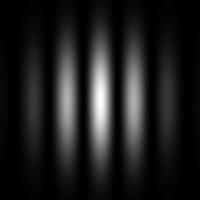I do not understand the question, because it starts with a wrong statement:
A superposition of two electromagnetic waves with different frequencies will never produce visible interference patterns.
This statement is clearly false. Take, for example, the diffraction pattern from a double slit with a single frequency:
If you take a wavelength that is 10% longer you get a slightly wider spacing:
When you superpose the two wavelength, the intensity that you get is simply the sum of the two. The result still has a very clear diffraction pattern, showing interference:
It is easy to prove that the intensities of the two waves with different wavelength are simply added. Let us say that the first wave is: $$ \varphi_1 = \psi_1(x) e^{i \omega_1 t} $$ and the second: $$ \varphi_2 = \psi_2(x) e^{i \omega_2 t} $$ The square modulus of the superposition is: $$ |\varphi|^2 = \left| \varphi_1 + \varphi_2 \right|^2 $$ Substituting: $$ |\varphi|^2 = \left| \psi_1(x) e^{i \omega_1 t} + \psi_2(x) e^{i \omega_2 t} \right|^2 $$ This is equal to: $$ |\varphi|^2 = \left( \psi_1(x) e^{i \omega_1 t} + \psi_2(x) e^{i \omega_2 t} \right) \left( \psi_1(x) e^{i \omega_1 t} + \psi_2(x) e^{i \omega_2 t} \right)^* $$ The four terms are: $$ |\varphi|^2 = \psi_1(x) e^{i \omega_1 t} \psi_1(x)^* e^{-i \omega_1 t} + \psi_1(x) e^{i \omega_1 t} \psi_2(x)^* e^{-i \omega_2 t} + \psi_2(x) e^{i \omega_2 t} \psi_1(x)^* e^{-i \omega_1 t} + \psi_2(x) e^{i \omega_2 t} \psi_2(x)^* e^{-i \omega_2 t} $$ Some of the exponential cancel out: $$ |\varphi|^2 = \psi_1(x) \psi_1(x)^* + \psi_2(x) \psi_2(x)^* + 2 Re \left( \psi_1(x) \psi_2(x)^* e^{i (\omega_1-\omega_2) t} \right) $$ Calculating the intensity, the last term on the right averages to 0: $$ I = \psi_1(x) \psi_1(x)^* + \psi_2(x) \psi_2(x)^* = I_1 + I_2 $$
So, from the superposition of two diffraction patterns at different wavelengths you simply get the sum of the intensities. Normally, the diffractioninterference will still be visible.



